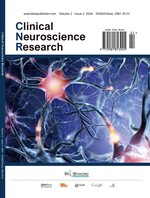Abstract
Objective: To improve the understanding of clinical and neurophysiological features of sensory neuronopathy and to achieve early diagnosis of the cause of sensory neuronopathy. Methods: This study retrospectively analyzed the clinical manifestations and neurophysiological features of 16 cases of sensory neuronopathy with a clear diagnosis. Results: The study subjects consisted of 6 males and 10 females, aged 42–71 years old, with a mean age of 55 years old. 10 cases were diagnosed with the sensation of walking on cotton, 4 cases complained of numbness and burning sensation in one or both hands, and 2 cases complained of weakness of the limbs. 4 cases had paraneoplastic sensory neuronopathy, 3 cases had autoimmune sensory neuronopathy, 2 cases had platinum-associated sensory neuronopathy, and 7 cases had idiopathic sensory neuronopathy. Sensory nerve action potentials were significantly reduced or lost in 16 patients, 12 cases were widespread in the limbs, and 4 cases were asymmetric. There was no obvious abnormality in motor nerve conduction. Conclusion: Sensory neuronopathies of various etiologies have common characteristic neurophysiological manifestations, and mastering the neurophysiological characteristics of sensory neuronopathies can lead to early identification of sensory neuronopathies.
References
Lauria G, Pareyson D, Sghirlanzoni A, 2003, Neurophysiological Diagnosis of Acquired Sensory Ganglionopathies. European Neurology, 50(3): 146–152.
Wu MY, Liu YM, Wang Z, 2019, Diagnosis and Treatment of Sensory Neuronopathy (with Report of 8 Cases). Shandong Medicine, 59(9): 54–57.
Lu RY, Zhang YX, Ding MP, 2015, Progress of Clinical Diagnosis and Treatment of Sensory Neuron Disease. China Clinical Neuroscience, 2015(2): 217–221.
Martinez ARM, Martins MP, Rezende TJR, et al., 2019, Autonomic Dysfunction is Frequent and Disabling in Non-paraneoplastic Sensory Neuronopathies. Journal of the Neurological Sciences, 2019(402): 111–117.
Wang WL, Li Y, Shi LF, et al., 2013, A Case of Dry Syndrome Combined with Sensory Neuropathy and Literature Review. China Clinical Neuroscience, 21(5): 566–569.
Xu YS, Zhang S, Fan DS, 2013, Clinical and Neurophysiological Study of Sensory Neuron Disease. Chinese Medical Journal, 93(13): 992–994.
Gwathmey KG, 2017, Sensory Polyneuropathies. Continuum (Minneapolis, Minn.), 23(5): 1411–1436.
Martinez ARM, Ribeiro MC, Lima FD, et al., 2019, Misdiagnosis and Diagnostic Delay in Non-Paraneoplastic Sensory Neuronopathies. Arquivos de Neuro-Psiquiatria, 2019(77): 451–455.
Gutierrez J, Palma JA, Kaufmann H, 2020, Acute Sensory and Autonomic Neuronopathy: A Devastating Disorder Affecting Sensory and Autonomic Ganglia. Seminars in Neurology, 2020(40): 580–590.
Mathis S, Duval F, Soulages A, et al., 2020, The Ataxic Neuropathies. Journal of Neurology, 2020(268): 3675–3689.
Camdessanché JP, Jousserand G, Ferraud K, et al., 2009, The Pattern and Diagnostic Criteria of Sensory Neuronopathy: A Case-Control Study. Brain, 132(7): 1723–1733.
Rudnicki SA, Dalmau J, 2005, Paraneoplastic Syndromes of the Peripheral Nerves. Current Opinion in Neurology, 18(5): 598–603.
Tholance Y, Moritz CP, Rosier C, et al., 2020, Clinical Characterisation of Sensory Neuropathy with Anti-FGFR3 Autoantibodies. Journal of Neurology, Neurosurgery, and Psychiatry, 91(1): 49–57.
Staff NP, Cavaletti G, Islam B, et al., 2019, Platinum-induced Peripheral Neurotoxicity: From Pathogenesis to Treatment. Journal of the Peripheral Nervous System, 24(2): S26–S39.
